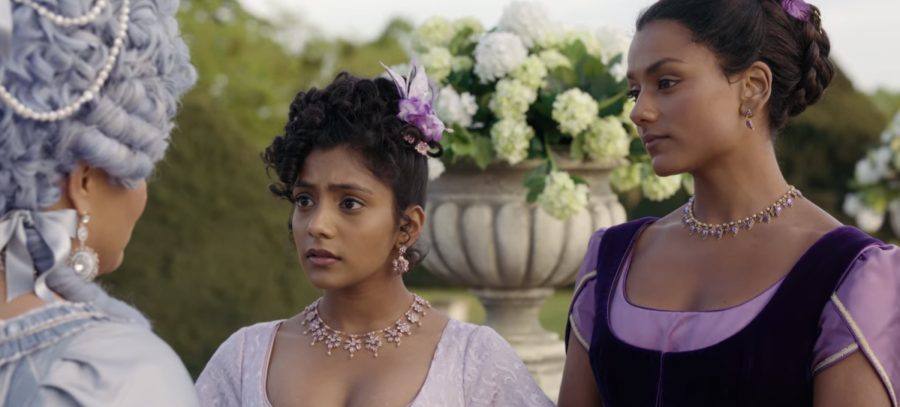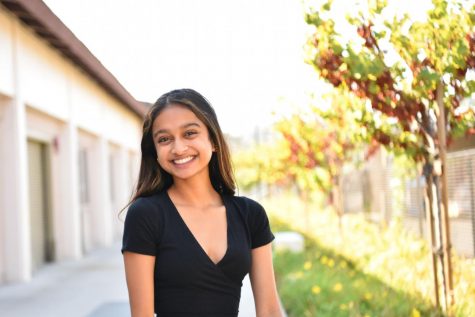“Bridgerton” is another disappointment in Indian representation
Cultural inaccuracies make for a paltry attempt at diversity
Charitha Chandran and Simone Ashley star as two of the leading characters on the second season of Birdgerton
April 3, 2022
The second season of Netflix’s “Bridgerton,” which aired on March 25, is the drama-infused next chapter in the stories of the provocative reimagination of the courting season in 19th Century England. Last year, “Bridgerton” made headlines because of the diversity of its cast — in this fantastical interpretation of the Regency period, whiteness is not a prerequisite for nobility, and race is merely an attribute that characters live with, not one that defines their entire identity. Though the Bridgertons, the upper-class and respected family that the show follows, is entirely white, prominent characters of color abound. The first season alone features several leading Black characters, including the main male love interest who happens to be the Duke of Hastings, an opinionated and all-knowing dowager and the Queen of England, played by Regé-Jean Page, Adjoa Andoh and Golda Rosheuvel, respectively.
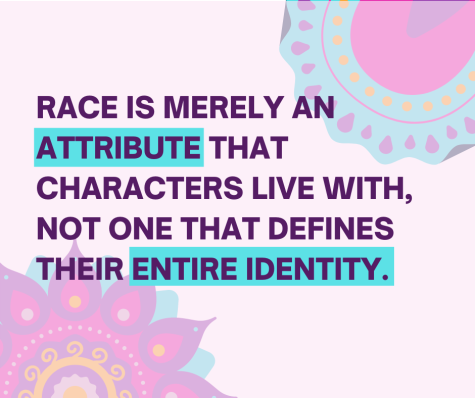
The show employed “color-conscious casting,” which is defined as “casting [that] intentionally considers the race and ethnicity of actors and the characters they play in order to oppose racism, honor and respect cultures, foster stronger productions, and contribute to a more equitable world.” The show’s creator and executive producer, Chris Van Dusen, explained that this emphasis on color-consciousness was a way for him to reimagine the Regency period in a way that reflected the multi-ethnic world we inhabit today.
“I wanted to turn the period genre on its head and reimagine it in a new and exciting way,” Van Dusen wrote in the Hollywood Reporter. “One that included characters of different colors and backgrounds. One that explored the topic of race. I wanted gay people to exist in this world. I wanted to expand this entire universe. My show would be about love. Joy. Triumph. It would be a show that says everyone is worthy and deserving of all of those things, and more.”
Van Dusen’s attempt at a universe of hedonistic romance tropes that is largely colorblind is successful to a degree. While some praised the first season of the show as a triumph in “frothy escapism,” others critiqued the way that characters of color, like Lady Danburry (the all-knowing dowager) and the Duke of Hastings (the main male love interest) “suffer from a lack of both interiority and context outside of their relationships to white characters.”
The second season of Bridgeron confronts this lack of context head-on by featuring the daughters of an Indian family, the Sharmas, as the central love interests of Anthony Bridgerton (played by Johnathon Bailey) in a heart-wrenching and passionate love triangle. The Sharmas have returned to London decades after the Sharma sisters’ mother, Lady Mary Sharma, (Shelley Conn) fell in love with a low class Indian clerk, was disowned by her parents and moved to Mumbai. Kate Sharma (Simone Ashley) is the clerk’s daughter from a previous marriage and the overprotective older sister to Edwina Sharma (Charithra Chandran). The girls’ father passes away long before the Sharma women arrive in London, leaving the family nearly penniless. In order to reclaim some of Lady Mary’s parents’ fortune, Kate sets on a mission to betroth her sister to English nobility, hence the trio’s stint in London.
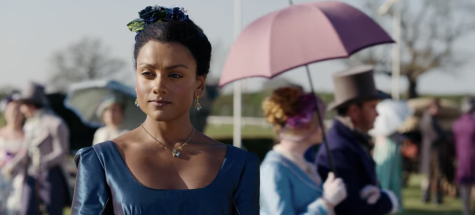
My excitement for the show’s second season began building as soon as I saw the trailer. Seeing Indian characters featured as the primary love interests in the show allowed me to more fully appreciate Van Dusen’s mission: this show was not meant to be historically accurate (in case the string quartet covers of “Wildest Dreams” by Taylor Swift during balls didn’t give this away) or an acknowledgement of the trauma and limitations imposed on people of color during the Regency period. In this show, girls like me could indulge in their Jane Austen fantasies and see representations of themselves on screen without having to confront the constant racism that any Indian person in 19th Century England would have faced.
Needless to say, I counted down the days until March 25. On Friday night, I sat in front of the TV equipped with a box of Thai takeout, a blanket and a heightened sense of anticipation. Within five minutes of the Sharmas onscreen introduction, my takeout was finished, my blanket was kicked to the side and my anticipation was replaced with a bitter sense of disappointment.
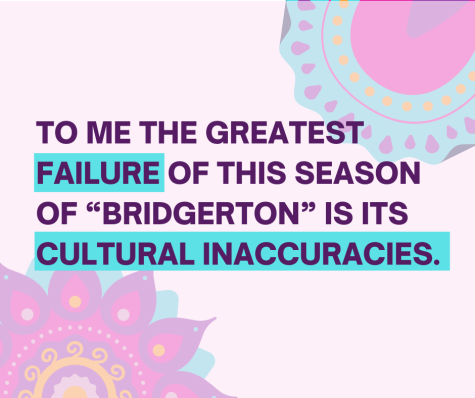
To me the greatest failure of this season of “Bridgerton” is its cultural inaccuracies. Both lead actresses are of Tamil origin and darker skinned — which is a feat of Indian diversity to be lauded in and of itself, as colorism and stereotyping in Bollywood has often stripped darker skinned and South Asian actresses of lead roles — and refer to their late father as “Appa,” but the references to South Indian culture end there. Their father’s last name is Sharma, which is a name that hails from North India. The girls speak Marathi and Hindi, languages in which the word for father is not “Appa.” They have lived in Mumbai for most of their lives, which is 811 miles from Tamil Nadu. Even their affectionate names for each other are a source of confusion — Edwina uses the Hindi word for older sister, “Didi,” to refer to Kate, but Kate calls Edwina “Bon,” which means younger sister in Bengali, which is a totally different language used in a totally different part of India.
The effect of these discrepancies are two characters that seem to be a paltry attempt at shoving as much culture as possible from the Indian subcontinent onto two women. A simple Google search on Indian culture reveals these tremendous rifts in the Indian characters’ narratives. The fact that a basic check on inaccuracies was either not performed or ignored for the two lead female characters in the entire season is infuriating.
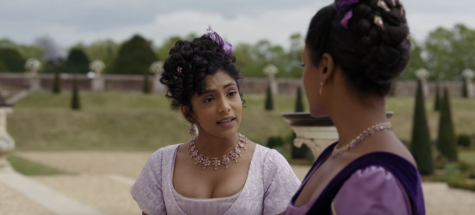
As an Indian American teenager and avid Jane Austen fan, the opportunity to see an echo of myself on screen, wearing the elaborate dresses and exchanging the steamy looks with nobility so characteristic of the Regency period was a prospect that had me excited for weeks. But representation is only valuable if it is accurate. The Indian subcontinent is 1.7 million square miles, home to 28 states, 22 official languages (and a far greater number of dialects) and countless cultures and traditions. But these traditions are different in different places. Perhaps the strange amalgam of Indian culture that makes up Edwina and Kate is an attempt to represent all Indians in one fell swoop. But I can honestly say that if the producers of “Bridgerton” had stuck to Ashley and Chandran’s Tamilian roots and created culturally and linguistically accurate depictions of the two sisters, I would have felt significantly more seen in the show, even though I’m not South Indian. But right now, all I feel is misrepresented.
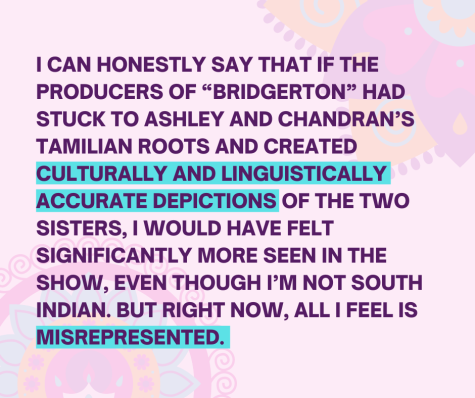
Van Dusen’s quest to create a “multi-ethnic” period should have included the prerequisite of accuracy. Van Dusen does accomplish his goal to a degree, specifically by creating a world in which Edwina and Kate are revered as the most beautiful women in the city, where their Indian culture is woven into their interactions and characterization without being Westernized and where they are allowed to exist as Indians second and characters first, without their Indianness defining who they are completely or embodying easy stereotypes. And this is indicative of the way that on screen South Asian representation has certainly been increasing in recent years, most notably with shows that star Indian characters like Mindy Kaling’s “Never Have I Ever.” But even in shows like this, nuanced accuracies of Indians abound. I refuse to settle for pitiful echoes of what true Indians are and Indian culture is. I refuse to settle for characters and storylines that apparently pay no mind to 811 mile cultural separations — which is, by the way, roughly the distance between Frankfurt and Rome.
Seeing two Indian girls playing significant roles in a popular TV show is a source of great pride for me, and one that I genuinely believe represents a great deal of progress. But if I do not expect Italian characters to refer to their sisters as “schwester” instead of “sorella,” why should I accept when Indian characters do the equivalent?



